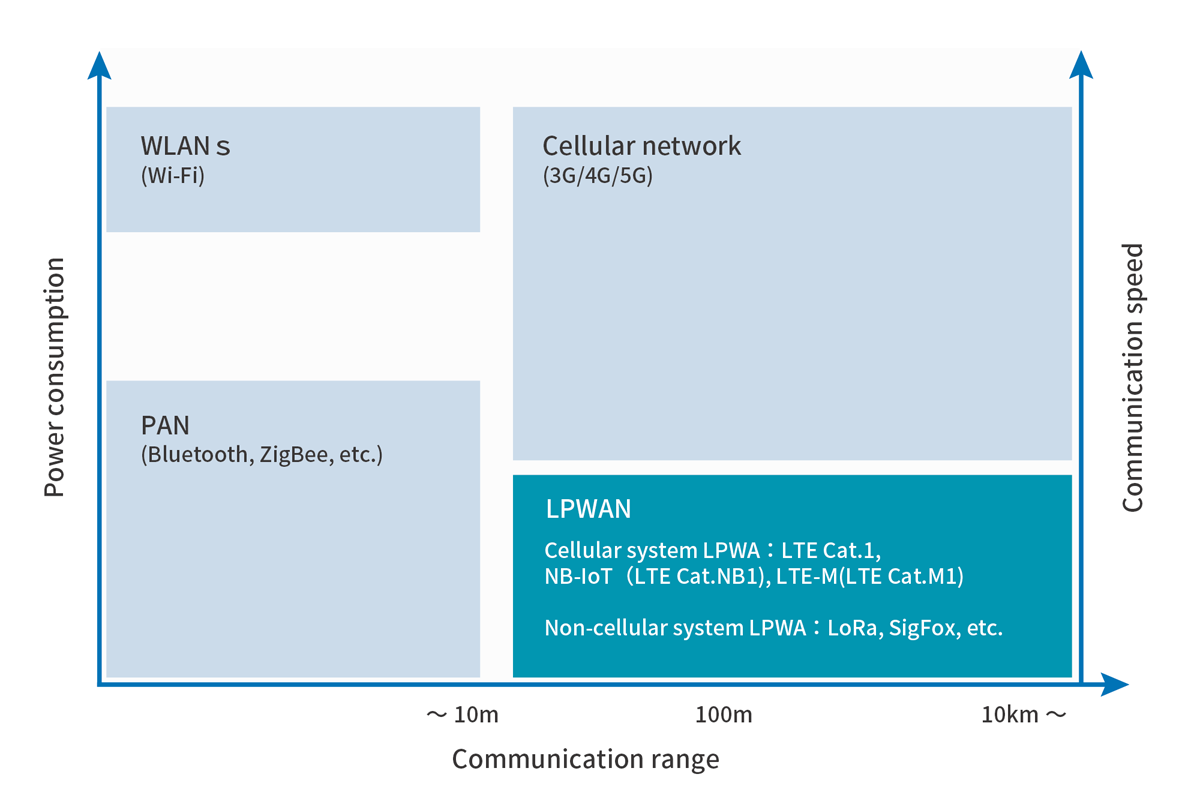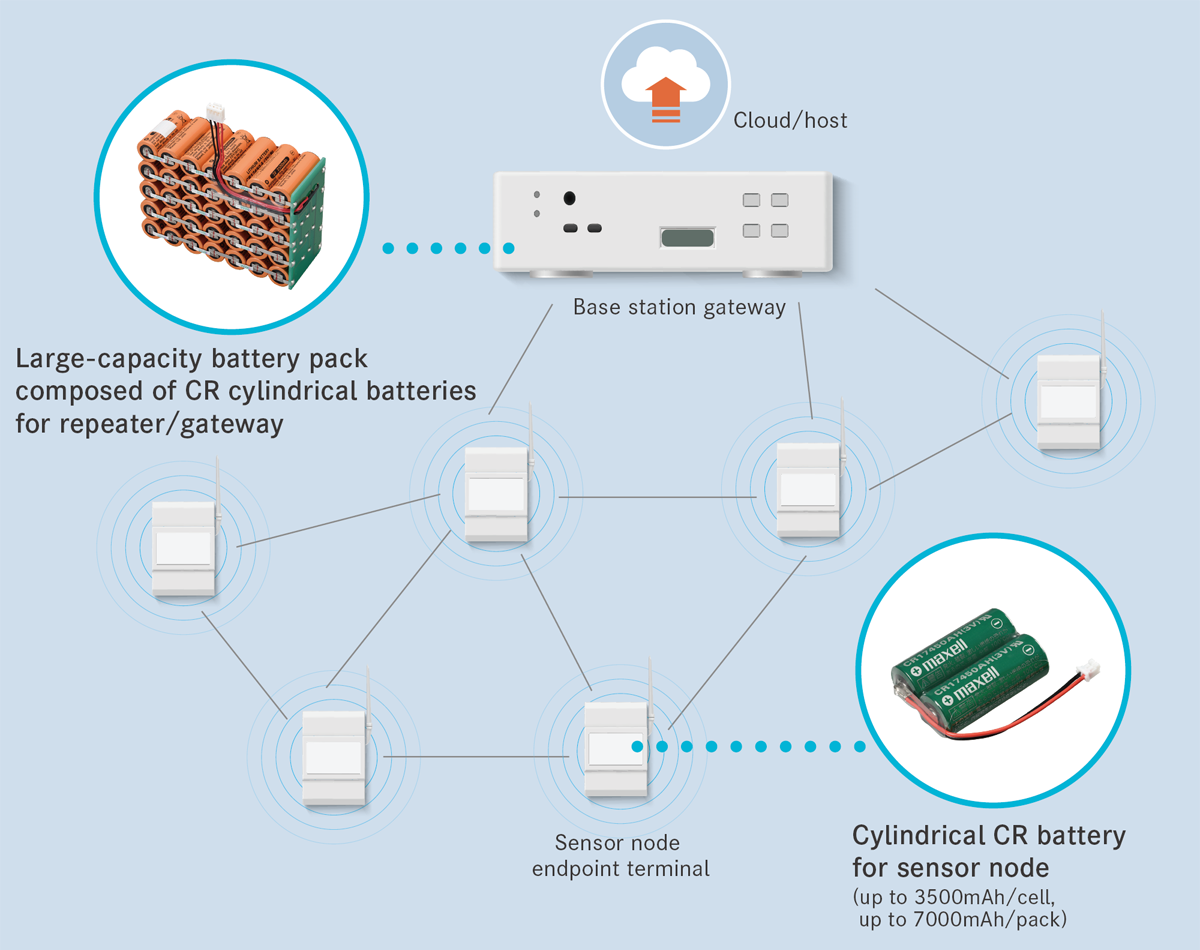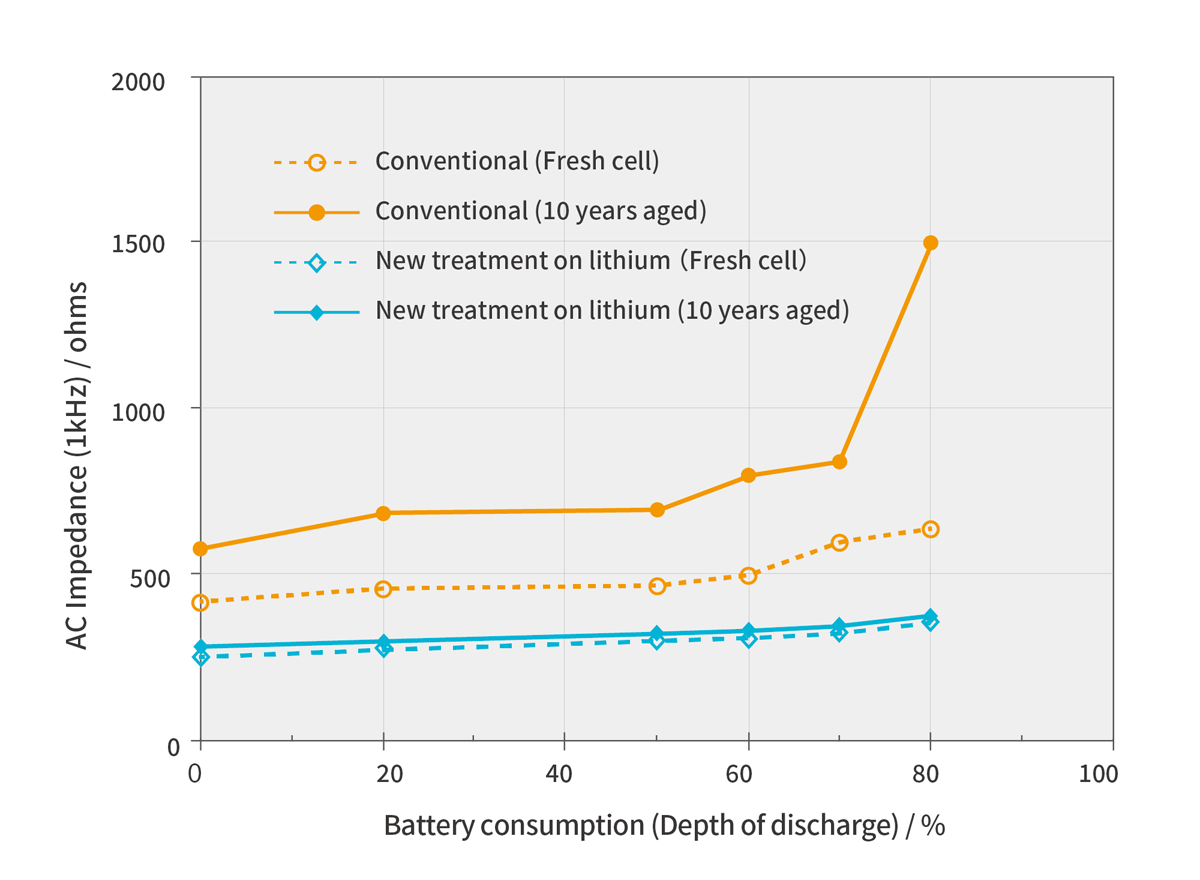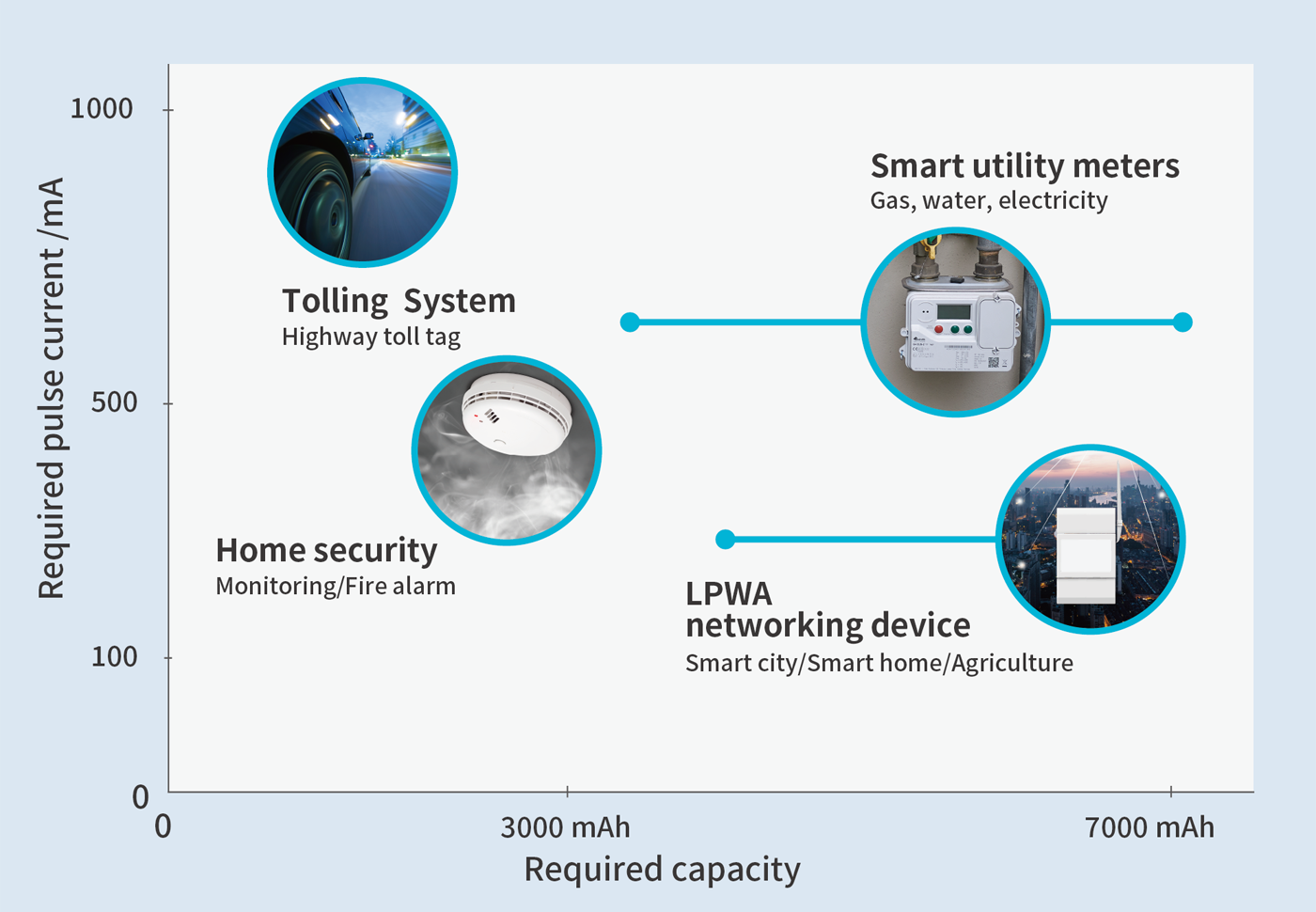Technical article: IoT society and batteries
| Realizing IoT society with CR cylindrical batteries | ||
| Battery solutions suitable for LPWA communication devices |
Key components in IoT society
The IoT (Internet of Things), which has so far been the subject of endeavors in many fields, seems to be endlessly expanding with the continuing expansion of communication technologies. IoT devices have a very strong connection to battery technology, and Maxell has been working on technological development with a view to applications for smart meters, communication equipment terminals, etc.
In this article, we will introduce a cylindrical type lithium manganese dioxide battery (hereafter referred to as a CR cylindrical battery) suitable for use as a power source for communication devices and repeaters that are required for such communication network configurations.
CR cylindrical battery for LPWA repeater and sensor node terminals
There are four main types of networks that can be used to configure a network using IoT devices: wireless local area network (WLAN, Wi-Fi, etc.), personal area network (PAN, Bluetooth, ZigBee, etc.), low power wide area network (LPWA, LoRa, Sigfox, etc.), and cellular network. The method of communication is selected according to the location where the network is configured or its application. In the case of water, gas, and other smart meters, for example, cases where a mesh network is configured that utilizes hops between endpoint terminals, enabling efficient and reliable communication, are common in urban areas.

Relationship between communication range and power consumption (communication speed) of various communication technologies
LPWA communication is a technology that enables long-distance data communication with low power consumption. It is attracting attention as a communication method that is suitable for IoT applications. While batteries are not required to have the same high current discharge characteristics as Wi-Fi or cellular communications, there may be restrictions on where the equipment can be installed. Thus, batteries with high energy density while having sufficient discharge performance are required.

Mesh network configured with hops between communication terminals. The multi-cell pack of the CR cylindrical battery is suitable as a power source for sensor terminals, and the large-capacity battery pack is suitable as a power supply for repeaters and gateways.
Maxell has developed CR17500AU high-capacity CR cylindrical battery, which is suitable for such communication device applications. This battery realizes the highest capacity in the industry∗1 for CR cylindrical batteries and is expected to reduce battery consumption compared with existing CR cylindrical batteries. It will lead to a reduction in the number of parts used by communication device manufacturers and the space required by equipment.
- Highest capacity in the industry: According to research in 17500 size cylindrical type lithium manganese dioxide battery by Maxell as of February 17th, 2021
Features of Maxell's CR cylindrical batteries
Maxell commercialized the CR cylindrical battery in 2005. It is used in smart meters and IoT communication devices, etc. because of its particularly stable discharge characteristics over long periods of time. In this section we will introduce the novel technology used to achieve this kind of performance.
Unique electrode structure
Winding type and bobbin type electrode structures are common in CR cylindrical batteries. While the winding type electrode structure enables large current discharge, its density cannot easily be increased. The bobbin type electrode structure is inferior to the winding type in terms of large current loads despite its high energy density. Maxell concentrated on this particular point, and developed a unique winding electrode whose required load current density and thickness have been optimized with the aim of achieving both large current characteristics and a high capacity suitable for communication device applications.

Comparison of important characteristics of CR cylindrical batteries according to electrode structure
Long-term reliability technology
The long-term reliability technology that is required especially for IoT communication terminals used over long periods of time, such as smart meters, is introduced in this section.
Tightly sealed structure
Airtightness is ensured by a heat resistant gasket and laser sealing to suppress performance deterioration due to electrolyte evaporation, water intrusion from outside, etc.
Electrolyte solution
By optimizing the electrolytes, which play an important role in battery reactions, not only discharge performance, but also the long-term reliability of the battery is improved by suppressing gas generation during long-term use, etc.
Lithium electrode
By applying surface treatment to lithium metal surface, which has high energy density, the electrode exhibits stable performance over long periods of time.
These technologies, for example, suppress increases in impedance during long-term use, ensuring long-term reliability for 10 years∗2.
∗2long-term reliability for 10 years: Designed lifetime at 20 deg. C when not yet used. Actual lifetime will vary depending on conditions such as discharge current and temperature.

Relationship between battery consumption capacity and internal resistance for unused CR cylindrical battery and CR cylindrical battery after storage equivalent to 10 years
Battery type: CR17450 (battery size: Diameter 17mm, Height 45mm).
The internal resistances of an unused battery and a battery that had been stored for 57 days at 80 deg. C (reproducing deterioration equivalent to 10 years at room temperature) were measured at 20 deg. C at predetermined measurement points after discharging a specified capacity.
This data is experimental data for verifying the effectiveness of improvements and values are not guaranteed. For actual performance, please contact Maxell.
CR cylindrical batteries product range
| Model | CR17335A | CR17450A | CR17450AH | CR17500AU | |
|---|---|---|---|---|---|
| Nominal Voltage (V) | 3 | 3 | 3 | 3 | |
| Nominal Capacity (mAh)∗1 | 1650 | 2500 | 3000 | 3500 | |
| Energy Density (Wh/L)∗2 | 651 | 735 | 882 | 926 | |
| Nominal Discharge Current (mA) | 5 | 5 | 1 | 1 | |
| Max. Pulse Discharge Current (mA)∗3 | 1500 | 3000 | 2000 | 2500 | |
| Operating Temperature Range (deg. C)∗4 | -40 to +85 | ||||
| Dimensions∗5 | Diameter (mm) | 17 | 17 | 17 | 17 |
| Height (mm) | 33.5 | 45 | 45 | 50 | |
| Weight (g)∗5 | 17 | 22 | 24 | 26 | |
- Nominal capacity of CR17500AU indicates duration until the voltage drops to 1.5V when discharged at a nominal discharge current at 20 deg. C.
As for other models, nominal capacity indicates duration until the voltage drops to 2.0V when discharged at a nominal discharge current at 20 deg. C. - Obtained by the calculation formula: energy density = nominal capacity × nominal voltage ÷ cell volume
This is a value calculated to show the relative energy density of each model. - At DOD50%, current values above 1.0V (20 deg. C) and maximum pulse discharge current are guides to the discharge performance of each cell, and values vary depending on the actual conditions of use. For actual performance values under individual conditions, please contact Maxell.
- When using at temperatures exceeding 60 deg. C, please consult Maxell in advance for conditions of use.
- Dimensions and weight are of the battery itself and vary depending on specifications.
These data and dimensions are not guaranteed values. For details, please contact Maxell.
Maxell's battery solutions for communication terminals in future
Maxell's CR cylindrical batteries, which have the above special features achieved by numerous unique technologies, are being considered and adopted not only for IoT applications, but also for various other applications.

Pulse discharge current and capacity distribution required for communication devices
Related products
Inquiry form related to cylindrical type lithium manganese dioxide batteries (CR)
We look forward to hearing from you regarding selection of battery products, sample consultations, etc. Please feel free to contact Maxell.


